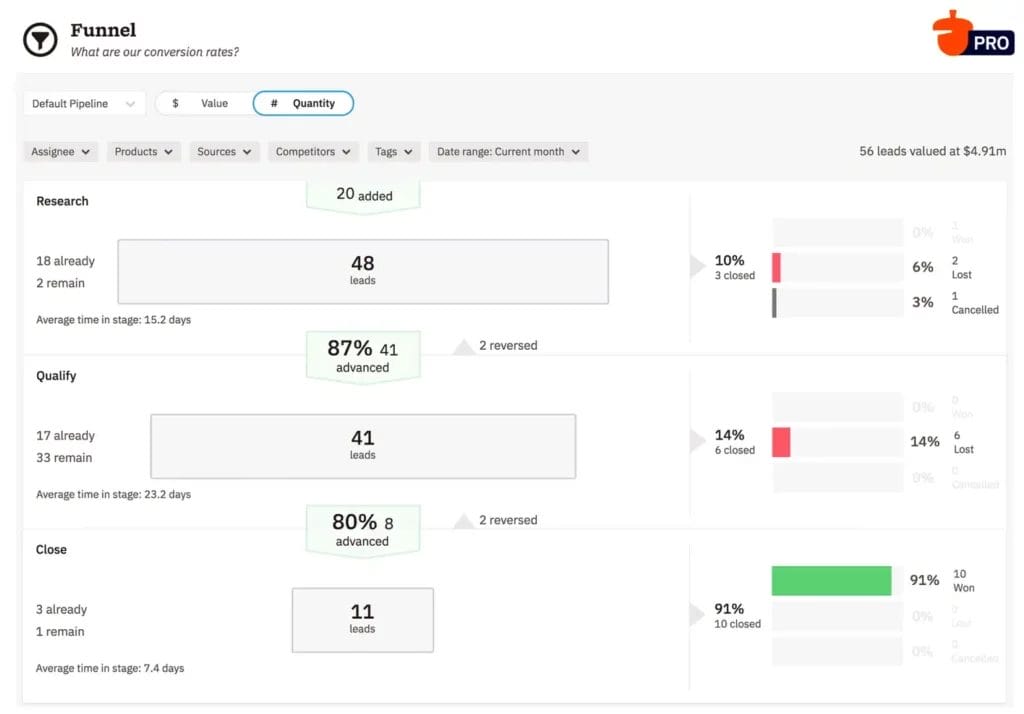
As a startup, having a well-running sales pipeline is vital to facilitate sales actions and help your team close deals faster.
Read on to learn more about the importance of sales pipelines for your business and how to manage a sales pipeline for your startup.
A sales pipeline is an organized series of stages and tasks that follow the buyer’s journey from lead to customer. It defines the actions that sales reps should take that are relevant to where the lead is in their journey to facilitate the sales process.
Typical sales pipeline stages include prospecting, qualifying, building client relationships, and closing.
A good sales pipeline does wonders for the growth of companies of every size and in every industry.
In the often chaotic world of startups, a sales pipeline is an anchor that helps your team stay on top of tasks to ensure you hit objectives and key results (OKRs).
A well-managed pipeline gives you a smoother lead-to-close process that everyone on the team can follow. It takes the guesswork out of sales team activity and gives them the confidence to take action in the sales process.
Nutshell has what you’re looking for.

A great sales pipeline can help your startup business process go much smoother and take the guesswork out of sales actions. Here are some best practices for optimizing and managing your sales pipeline.
Leads are the people and companies that enter your pipeline and move their way through the buyer’s journey.
Only a fraction of all the leads that go through your pipeline will close, and startups often don’t have the time and resources to follow up on every possible lead.
So, instead of trying to win each and every lead – exhausting your sales team in the process – you can measure the quality of your leads and prioritize high-quality leads by using lead scoring.
Lead scoring is giving a score to leads every time they take specified actions or meet specified criteria. For example, scoring actions could include opening promotional emails frequently or having a specific number of employees at their company.
With Nutshell, you can manually label leads as Hot Leads – leads most likely to close, or those that are more meaningful to you – and allow your sales team members to prioritize them too.

The higher the lead score, the more likely that they will convert, so it’s best to prioritize these high-quality leads.
On the other hand, leads that consistently score low (they’re not opening emails, answering calls, etc.) should be dropped from your list after some time. It’s best practice to clean your lead and contact list regularly.
Recognizing and eliminating unproductive leads is just as important as focusing on your best leads for pipeline efficiency.
Whether you choose to do this on a weekly, monthly, or quarterly basis, it’s essential to analyze your sales process and performance regularly. Important key metrics to check include:
Knowing the performance of your sales pipeline and sales team allows you to extract actionable insights. You can use these insights to make decisions on how to optimize your pipeline and process.
Using Nutshell CRM, you get actionable insights and real-time data on sales performance, team productivity, and lead volume. You can also check your conversion rates at each stage of your pipeline to identify where deals are getting stuck.

All of this data is helpful when you’re looking to implement improvement strategies in your pipeline.
After you analyze your sales pipeline, you’ll have enough data to make changes to the process where necessary. It’s crucial to the health of your pipeline to update your stages and tasks often and regularly, especially as you scale your startup and introduce new features or products.
Your sales pipeline updates should also improve your process wherever you see significant dropoffs or time spent at certain stages.
As your business grows to scale, so will your sales team. That’s why it’s important to keep everyone in the loop when it comes to the sales process.
Putting the upfront effort and time into creating a standardized process – a universal set of stages and tasks for all sales – will help you develop consistent workflows, ensure uniformity in sales approaches, and help you monitor individual performance.
A standardized sales pipeline will also make the onboarding process for new sales team members easier.
Many of the aforementioned best practices can be made simpler with the help of great sales software, such as customer relationship management (CRM) software.
CRMs help you manage your lead database, streamline your sales pipeline, and keep track of every new development in the same place.
Nutshell was built with small businesses in mind. Our affordable, scalable, and robust CRM offers excellent features for startups at a fraction of the cost of other CRMs. Design every stage yourself, or choose a pre-built Nutshell pipeline starter template to handle the heavy lifting so you can zero in on sales.
Nutshell’s goal is simple: we help your business make more sales with contact and pipeline management software.
With a simple-to-use CRM like Nutshell, you can streamline your startup sales process and reach your business growth goals faster.
Create your first customized sales pipeline with Nutshell today when you sign up for a 14-day free trial. Or contact our team today to learn more.
Most startups should aim for 5-7 pipeline stages. Start with the basics: prospecting, qualification, demo/meeting, proposal, negotiation, closing, and post-sale. If you’re just getting started, keep it simple with 4-5 stages and add more as your process matures. The key is matching stages to your actual buyer’s journey—not creating stages just because other companies have them.
For B2B startups, a lead-to-customer conversion rate of 1-5% is typical, with rates above 5% considered excellent. Your free trial to paid conversion should aim for 10-20% (above 20% is outstanding). Focus less on hitting “perfect” numbers and more on tracking your rates consistently so you can spot trends and improve over time.
You can build a basic sales pipeline in 1-2 weeks. Start by mapping your current sales process, defining 4-5 key stages, and setting up your CRM. The real work comes after launch—expect 2-3 months of refinement as you test, gather data, and adjust stages based on what actually happens with real deals.
Start with a CRM once you’re managing more than 10 active leads or have multiple team members selling. Spreadsheets work for initial validation, but they quickly become unmanageable and you’ll lose valuable data. A CRM like Nutshell helps you track conversations, automate follow-ups, and analyze what’s working—capabilities that directly impact your close rate.
The biggest mistake is letting deals sit too long without updating their stage or close date. This creates a “bloated pipeline” full of dead opportunities that skew your forecasts and waste your team’s time. Set objective criteria for moving deals between stages based on customer actions (not just your activities), and regularly clean out stalled deals.
Give our powerful, easy-to-use CRM a try for free for 14 days! Or join a live demo to see Nutshell at work!


Join 30,000+ other sales and marketing professionals. Subscribe to our Sell to Win newsletter!
